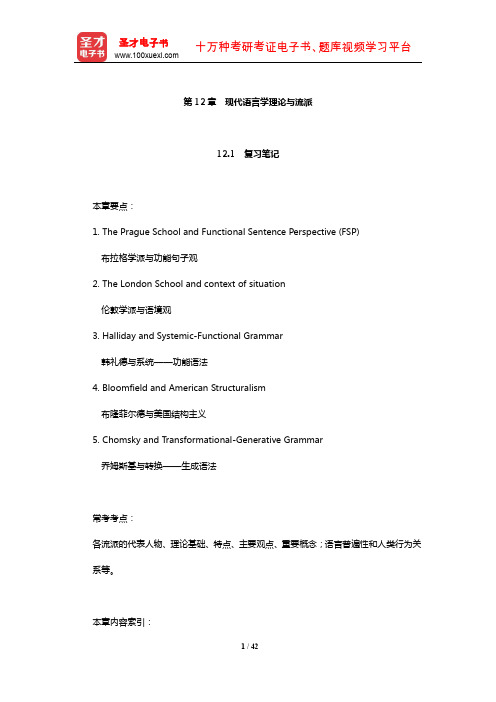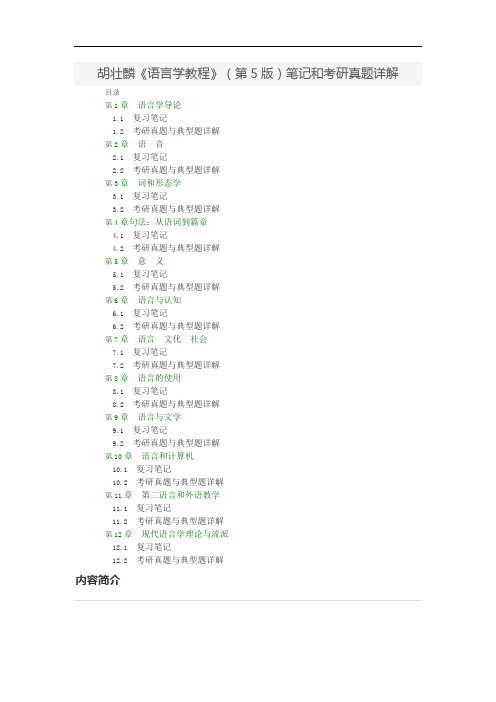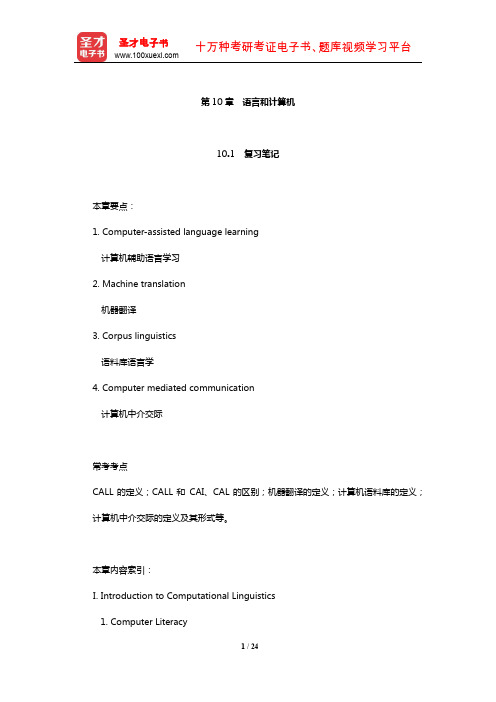胡壮麟《语言学教程》笔记和考研真题及典型题详解(第二语言和外语教学)【圣才出品】
胡壮麟《语言学教程》笔记和考研真题详解(现代语言学理论与流派)【圣才出品】

第12章现代语言学理论与流派12.1 复习笔记本章要点:1. The Prague School and Functional Sentence Perspective (FSP)布拉格学派与功能句子观2. The London School and context of situation伦敦学派与语境观3. Halliday and Systemic-Functional Grammar韩礼德与系统——功能语法4. Bloomfield and American Structuralism布隆菲尔德与美国结构主义5. Chomsky and Transformational-Generative Grammar乔姆斯基与转换——生成语法常考考点:各流派的代表人物、理论基础、特点、主要观点、重要概念;语言普遍性和人类行为关系等。
本章内容索引:I. Saussure and modern linguisticsII. The Prague School1. Main points and contribution2. Functional Sentence Perspective (FSP)3. Communicative Dynamism (CD)III. The London School1. Introduction2. Malinowski’s theories3. Firth’s theories4. Halliday and Systemic-Functional Grammar5. Systemic grammar and Functional grammar(1) Systemic grammar(2) Functional grammarIV. American Structuralism1. Introduction2. Three stages of the developmentV. Transformational-Generative Grammar1. Introduction2. The Innateness Hypothesis3. Generative Grammar4. Stage of development of TG Grammar5. Main features of TG GrammarI. Saussure and modern linguistics (索绪尔和现代语言学)Modern linguistics has started from the Swiss linguist Ferdinand de Saussure (1857-1913) , who is often described as “father of modern linguistics” and “a master of a discipline which he made modern”.According to Saussure, language is a system of signs which uses sounds to express and exchange ideas. The sign is the union of a form and an idea, i.e. the signifier and the signified. The sign is the central fact of language, and therefore the study of language must start from the nature of the sign itself.Saussure identifies several groups of important concepts: signifier and signified, langue and parole, synchronic and diachronic research, etc.现代语言学始于瑞士语言学家索绪尔,他被称为“现代语言学之父”和一位“使语言学走向现代的大师”。
胡壮麟《语言学教程》(第3、4版)笔记和考研真题详解(1-6章)【圣才出品】

第1章语言学导论1.1复习笔记本章要点:1.The definition and the design features of language语言的定义与特征2.The origin and the function of language语言的起源和功能3.Main branches of linguistics study语言学研究的范围和内容4.Important distinctions in Linguistics语言学的一些重要区分本章考点:1.有关语言的常考考点语言的定义;语言的基本特征(任意性、二重性、多产性、移位性、文化传递和互换性);语言的功能(提供信息、人际交往、施为、表达情感、寒暄、娱乐、元语言);语言的起源(神授说,人造说(“汪汪”,“噗噗”,“哟-嘿-吼”理论),进化说)等。
2.有关语言学的常考考点(1)语言学的定义,现代语言学与传统语法学研究的三个显著区别。
(2)语言学研究的四个原则及其简要说明。
语言学中几组重要区别,每组两个概念的含义、区分及其意义。
(3)普通语言学的主要分支学科及各自的研究范畴。
(4)宏观语言学及应用语言学的主要分支及各自的研究范畴。
本章内容索引:I.Definition of languageII.Design features of language1.Arbitrariness2.Duality3.Creativity4.Displacement5.Cultural Transmission6.InterchangeabilityIII.Origin of language1.The Biblical account2.The bow-wow theory3.The pooh-pooh theory4.The yo-he-ho theory5.The evolution theoryIV.Functions of languagermative function2.Interpersonal function3.Performative function4.Emotive function5.Phatic function6.Recreational function7.Metalingual functionV.Definition of linguisticsVI.Branches of linguistics1.Microlinguistics2.MacrolinguisticsVII.Important concepts and their distinctions1.Descriptive vs.Prescriptive2.Synchronic vs.Diachronicngue vs.Parolepetence vs.Performance5.Etic vs.Emic6.Traditional Grammar vs.Modern Grammar7.Linguistic Potential vs.Actual Linguistic BehaviorI.The definition of language(语言的定义)Language is a system of arbitrary vocal symbols used for human communication.This definition has revealed five essential factors of language:systematic,arbitrary,vocal,symbolic语言是人类以口头交流的任意的符号系统。
胡壮麟《语言学教程》笔记和考研真题详解(语言与认知)【圣才出品】

第6章语言与认知6.1 复习笔记本章要点:1. Psycholinguistics心理语言学2. Language acquisition, language comprehension, language production 语言习得,语言的理解,语言的生成3. First language acquisition第一语言习得4. Cognitive linguistics认知语言学常考考点:语言习得;第一语言习得;语言的理解和生成;范畴;隐喻;整合理论等。
本章内容索引:I. Definition of cognitionII. Definition of PsycholinguisticsIII. Language acquisition1. The Behaviorist Approach2. The Innateness HypothesisIV. Language comprehension1. Sound Comprehension2. Word recognition3. Comprehension of sentences4. Comprehension of textV. Language Production1. Access to words2. Generation of sentences3. Written language productionVI. Cognitive Linguistics1. Definition2. Construal and Construal Operations(1) Attention/ Salience(2) Judgment/ Comparison(3) Perspective/ Situatedness3. Categorization(1) Basic level(2) Superordinate level(3) Subordinate level4. Image Schemas5. Metaphor(1) Ontological metaphors(2) Structural metaphors(3) Orientional metaphors6. Metonymy7. Blending TheoryI. Definition of cognition (认知的定义)Cognition is used in several different loosely related disciplines. In psychology it is used to refer to the mental processes of an individual, with particular relation to a concept which argues that the mind has internal mental states (such as beliefs, desires and intentions) and can be understood as information processing, especially when much abstraction or concretization is involved, or processes such as involving knowledge, expertise or learning for example are at work. Another definition of “cognition” is the mental process or faculty of knowing, including aspects such as awareness, perception, reasoning, and judgment.“认知”一词既可用于不同学科也可用于相关学科。
胡壮麟《语言学教程》(第5版)笔记和考研真题详解

胡壮麟《语言学教程》(第5版)笔记和考研真题详解目录第1章语言学导论1.1复习笔记1.2考研真题与典型题详解第2章语音2.1复习笔记2.2考研真题与典型题详解第3章词和形态学3.1复习笔记3.2考研真题与典型题详解第4章句法:从语词到篇章4.1复习笔记4.2考研真题与典型题详解第5章意义5.1复习笔记5.2考研真题与典型题详解第6章语言与认知6.1复习笔记6.2考研真题与典型题详解第7章语言文化社会7.1复习笔记7.2考研真题与典型题详解第8章语言的使用8.1复习笔记8.2考研真题与典型题详解第9章语言与文学9.1复习笔记9.2考研真题与典型题详解第10章语言和计算机10.1复习笔记10.2考研真题与典型题详解第11章第二语言和外语教学11.1复习笔记11.2考研真题与典型题详解第12章现代语言学理论与流派12.1复习笔记12.2考研真题与典型题详解内容简介作为《语言学教程》(第5版)(胡壮麟主编,北京大学出版社)的学习辅导书,全书完全遵循该教材的章目编排,共分12章,每章由两部分组成:第一部分为复习笔记(中英文对照),总结本章的重点难点;第二部分是考研真题与典型题详解,精选名校经典考研真题及相关习题,并提供了详细的参考答案。
本书具有以下几个方面的特点:1.梳理章节脉络,浓缩内容精华。
每章的复习笔记以该教材为主并结合其他教材对本章的重难点知识进行了整理,并参考了国内名校名师讲授该教材的课堂笔记,因此,本书的内容几乎浓缩了经典教材的知识精华。
2.中英双语对照,凸显难点要点。
本书章节笔记采用了中英文对照的形式,强化对重要难点知识的理解和运用。
3.精选考研真题,补充难点习题。
本书精选名校考研真题及相关习题,并提供答案和详解。
所选真题和习题基本体现了各个章节的考点和难点,但又不完全局限于教材内容,是对教材内容极好的补充。
另外,在笔记部分,对于在《语言学教程》第三版或第四版提到而第五版删减的知识点我们也予以保留,并用“*”标明,部分院校考研真题依旧会涉及这些知识点的考查。
(完整版)胡壮麟语言学教程笔记、重点全解

(完整版)胡壮麟语言学教程笔记、重点全解《语言学教程》重难点学习提示第一章语言的性质语言的定义:语言的基本特征(任意性、二重性、多产性、移位、文化传递和互换性);语言的功能(寒暄、指令、提供信息、询问、表达主观感情、唤起对方的感情和言语行为);语言的起源(神授说,人造说,进化说)等。
第二章语言学语言学定义;研究语言的四大原则(穷尽、一致、简洁、客观);语言学的基本概念(口语与书面语、共时与历时、语言与言学、语言能力与言行运用、语言潜势与语言行为);普通语言学的分支(语音、音位、语法、句法、语义);;语言学的应用(语言学与语言教学、语言与社会、语言与文字、语言与心理学、人类语言学、神经语言学、数理语言学、计算语言学)等。
第三章语音学发音器官的英文名称;英语辅音的发音部位和发音方法;语音学的定义;发音语音学;听觉语音学;声学语音学;元音及辅音的分类;严式与宽式标音等。
第四章音位学音位理论;最小对立体;自由变异;互补分布;语音的相似性;区别性特征;超语段音位学;音节;重音(词重音、句子重音、音高和语调)等。
第五章词法学词法的定义;曲折词与派生词;构词法(合成与派生);词素的定义;词素变体;自由词素;粘着词素(词根,词缀和词干)等。
第六章词汇学词的定义;语法词与词汇词;变词与不变词;封闭词与开放词;词的辨认;习语与搭配。
第七章句法句法的定义;句法关系;结构;成分;直接成分分析法;并列结构与从属结构;句子成分;范畴(性,数,格);一致;短语,从句,句子扩展等。
第八章语义学语义的定义;语义的有关理论;意义种类(传统、功能、语用);里奇的语义分类;词汇意义关系(同义、反义、下义);句子语义关系。
第九章语言变化语言的发展变化(词汇变化、语音书写文字、语法变化、语义变化);第十章语言、思维与文化语言与文化的定义;萨丕尔-沃夫假说;语言与思维的关系;语言与文化的关系;中西文化的异同。
第十一章语用学语用学的定义;语义学与语用学的区别;语境与意义;言语行为理论(言内行为、言外行为和言后行为);合作原则。
胡壮麟《语言学教程》笔记和考研真题详解(语言和计算机)【圣才出品】

第10章语言和计算机10.1 复习笔记本章要点:1. Computer-assisted language learning计算机辅助语言学习2. Machine translation机器翻译3. Corpus linguistics语料库语言学4. Computer mediated communication计算机中介交际常考考点CALL的定义;CALL和CAI、CAL的区别;机器翻译的定义;计算机语料库的定义;计算机中介交际的定义及其形式等。
本章内容索引:I. Introduction to Computational Linguistics1. Computer Literacy2. Computational LinguisticsII. Computer-assisted Language Learning1. CAI/CAL vs. CALL2. Phases of CALL Development3. TechnologyIII. Machine Translation (MT)1. Definition and Categories2. History of Development of MT3. Research Methods(1) The linguistic approach(2) The transfer approach(3) The interlingual approach(4) The knowledge-based approach4. MT and the Internet5. Speech Translation6. MT and Human TranslationIV. Corpus Linguistics1. Corpus and Corpus Linguistics2. Criticisms and Revival3. Concordance4. The Roles of Corpus DataI. Introduction to Computational Linguistics (计算机语言学简介)1. Computer Literacy (计算机操作能力)It refers to people who have sufficient knowledge and skill in the use of computers and computer software.特指那些能使用计算机并具有大量计算机软件知识和技巧的人。
胡壮麟《语言学教程》考研真题精选(判断正误)【圣才出品】
【答案】F 【解析】At the primitive period of human beings, there wasn’t language.
10. Phonology studies speech sounds, including the production of speech, that is, how speech sounds are actually made, transmitted and received.(北二外 2015 研) 【答案】F 【解析】本题考查音系学的含义。音系学研究语言的语音系统的一门学科,包括对当代语言
【答案】F 【解析】本题考查句法学中并列和从属关系的定义。并列关系指的是两个语言单位的地位相
等,相互并列。从属关系指的是从属是语义上分清主次的手段是把次要的思想内容 置亍结构上的从属地位,从而突出句子的主要思想。因此该表述有误。
2. Onomatopoeic words can show the arbitrary nature of language.(清华 2000 研) 【答案】F 【解析】It is the exception of the arbitrariness of language.
学的核心内容。而奥斯汀提出的是言语行为理论,因此该表述有误。
6. Free morpheme may constitute words by themselves.(大连外国语学院 2008 研) 【答案】T
7. The Cooperative Principle, an important pragmatic principle proposed by P. Grice, aims to explain how we mean more than we say.(上外 2000 研) 【答案】T 【解析】合作原则是格莱斯提出的重要的语用原则,其目的是解释人们如何传达自己的会话
(完整版)胡壮麟语言学教程笔记、重点全解
《语言学教程》重难点学习提示第一章语言的性质语言的定义:语言的基本特征(任意性、二重性、多产性、移位、文化传递和互换性);语言的功能(寒暄、指令、提供信息、询问、表达主观感情、唤起对方的感情和言语行为);语言的起源(神授说,人造说,进化说)等。
第二章语言学语言学定义;研究语言的四大原则(穷尽、一致、简洁、客观);语言学的基本概念(口语与书面语、共时与历时、语言与言学、语言能力与言行运用、语言潜势与语言行为);普通语言学的分支(语音、音位、语法、句法、语义);;语言学的应用(语言学与语言教学、语言与社会、语言与文字、语言与心理学、人类语言学、神经语言学、数理语言学、计算语言学)等。
第三章语音学发音器官的英文名称;英语辅音的发音部位和发音方法;语音学的定义;发音语音学;听觉语音学;声学语音学;元音及辅音的分类;严式与宽式标音等。
第四章音位学音位理论;最小对立体;自由变异;互补分布;语音的相似性;区别性特征;超语段音位学;音节;重音(词重音、句子重音、音高和语调)等。
第五章词法学词法的定义;曲折词与派生词;构词法(合成与派生);词素的定义;词素变体;自由词素;粘着词素(词根,词缀和词干)等。
第六章词汇学词的定义;语法词与词汇词;变词与不变词;封闭词与开放词;词的辨认;习语与搭配。
第七章句法句法的定义;句法关系;结构;成分;直接成分分析法;并列结构与从属结构;句子成分;范畴(性,数,格);一致;短语,从句,句子扩展等。
第八章语义学语义的定义;语义的有关理论;意义种类(传统、功能、语用);里奇的语义分类;词汇意义关系(同义、反义、下义);句子语义关系。
第九章语言变化语言的发展变化(词汇变化、语音书写文字、语法变化、语义变化);第十章语言、思维与文化语言与文化的定义;萨丕尔-沃夫假说;语言与思维的关系;语言与文化的关系;中西文化的异同。
第十一章语用学语用学的定义;语义学与语用学的区别;语境与意义;言语行为理论(言内行为、言外行为和言后行为);合作原则。
语言学教程胡壮麟第5版考研笔记和题库答案
语言学教程胡壮麟第5版考研笔记和题库答案考研备战对于很多语言学专业的学生来说是一项重要而艰巨的任务。
为了帮助广大考生更好地应对语言学专业考试,胡壮麟教授编写了《语言学教程(第5版)》并提供了相应的考研笔记和题库答案。
本篇文章将对《语言学教程胡壮麟第5版》的考研笔记和题库答案进行综述,帮助考生更好地把握考试重点。
一、《语言学教程胡壮麟第5版》考研笔记1. 笔记的重要性《语言学教程胡壮麟第5版》的考研笔记在备考中起到了至关重要的作用。
通过整理笔记,可以帮助考生更好地理解语言学的基本理论,掌握各个分支领域的核心知识,同时也是巩固自己的学习成果和备考复习的一种有效方式。
2. 如何做好笔记(1)有条理性:在复习过程中,要有系统地进行笔记整理。
根据课本和教学材料的内容,将重点、难点以及需要记忆的内容整理出来,便于日后回顾和复习。
(2)简明扼要:考研笔记并非要冗长复杂,而是要抓住重点,用简洁的语言将知识要点记录下来。
这样可以提高笔记的效率,避免在复习时被琐碎的内容所干扰。
(3)互联互通:考研笔记不仅仅是个人的学习工具,也可以用来方便与他人的交流与分享。
可以使用不同的颜色标记出重要的知识点,使用图表等方式更加直观地呈现笔记内容,增强交流的效果。
3. 笔记的应用考研笔记可以在备考过程中起到很大的助益。
首先,它可以帮助考生们理解和掌握语言学的核心概念和理论,提高对知识的系统性认识;其次,笔记可以作为备考复习的参考工具,方便考生回顾和巩固知识点;最后,笔记还可以与教材、辅导书等进行对照,检验自己的学习效果,找出薄弱环节并有针对性地进行加强。
二、《语言学教程胡壮麟第5版》题库答案1. 题库的作用《语言学教程胡壮麟第5版》的题库对于考生来说是一份宝贵的复习资料,可以帮助考生更好地了解考试形式和考点要求,做到心中有数,有针对性地备考。
2. 题库的特点(1)全面覆盖:胡壮麟教授的题库涵盖了语言学各个分支领域的试题,包括但不限于语音学、语法学、语义学等。
胡壮麟《语言学教程》笔记和考研真题及典型题详解(语 音)【圣才出品】
第2章语音2.1 复习笔记本章要点:1. Speech Organs 发音器官2. Distinction, Classification and the Criteria of Description between Constants and Vowels辅音和元音的区别、分类及描写规则3. Coarticulation and Phonetic Transcriptions协同发音和语音转写4. Phonemes and Allophones音位和音位变体5. Phonological Processes, Phonological Rules and Distinctive Features音系过程、音系规则和区别特征6. Syllable Structure, Stress and Intonation音节结构、重音和语调常考考点:1. 语音学语音学的定义;音姿的定义;发音器官的英文名称;英语辅音的定义、发音部位、发音方法和分类;英语元音的定义和分类、基本元音;发音语音学;听觉语音学;声学语音学;语音标记,国际音标;严式与宽式标音法。
2. 音系学音系学的定义;音系学与语音学的联系和区别;音素、音位、音位变体、最小对立体、自由变体的定义;音位理论;自由变异;音位的对立分布与互补分布;语音的相似性;区别性特征;超语段音位学;音节;重音(词重音、句子重音);音高和语调。
本章内容索引I. The Definition of Phonetics and Phonology1. Phonetics2. Three Major Research Fields of Phonetics3. PhonologyII. Speech Organs▼1. Gestures2. Speech organs3. Voiceless sounds4. Voiced sounds5. IPAIII. Consonants and Vowels1. Definition2. Consonants(1) Manner of Articulation and Place of Articulation(2) Classification of Consonants3. Vowel(1) Cardinal vowels(2) Criteria of vowel description(3) Monophthongs, Diphthongs and Triphthongs IV. Coarticulation and Phonetic Transcriptions*1. Coarticulation*2. Phonetic TranscriptionV. Phonemes and Allophones1. Phoneme2. AllophonesVI. Phonological Processes and Distinctive Features1. Phonological processes2. Assimilation*3. Distinctive featuresVII. Suprasegmentals1. Suprasegmental features2. The Syllable Structure▼3. Sonority Scale▼4. Stress(1) Change of the stresses due to suffixes(2) Stresses in compounds and phrases5. Intonation and ToneI. The Definition of Phonetics and Phonology (语音学和音系学的定义)1. Phonetics (语音学)Phonetics studies how speech sounds are produced, transmitted, and perceived.语音学研究语音的发生、传递和感知。
- 1、下载文档前请自行甄别文档内容的完整性,平台不提供额外的编辑、内容补充、找答案等附加服务。
- 2、"仅部分预览"的文档,不可在线预览部分如存在完整性等问题,可反馈申请退款(可完整预览的文档不适用该条件!)。
- 3、如文档侵犯您的权益,请联系客服反馈,我们会尽快为您处理(人工客服工作时间:9:00-18:30)。
第11章第二语言和外语教学11.1 复习笔记本章要点:1. The relation between linguistics and language teaching语言学与语言教学之间的关系2. Grammar, input and language learning语法、输入与语言学习3. Interlanguage in language teaching语言教学中的中介语4. Linguistics and syllabus design语言学与教学大纲设计5. Contrastive analysis and error analysis对比分析与错误分析6. Corpus linguistics and language teaching语料库语言学与语言教学常考考点:语言学与语言教学的关系;语言学与语言学习;语言学与教学大纲设计;二语学习者的主要障碍;对比分析与错误分析;中介语;语料库语言学与语言教学等。
本章内容索引:I. Definition of Applied LinguisticsII. The Relation between Linguistics and Language Teaching III. Linguistics and Language Learning1. Grammar and Language Learning2. Input and Language Learning3. Interlanguage in Language LearningIV. Linguistics and Language T eaching1. The discourse-based view of language teaching2. The universal grammar (UG) and language teaching V. Syllabus Design1. Syllabus and curriculum2. Theoretical views behind syllabus design3. Types of syllabus(1) The structural syllabus(2) The situational syllabus(3) The communicative syllabus(4) The task-based syllabus4. Current trends in syllabus design(1) The co-existence of the old and the new(2) The emphasis on the learning process(3) The inclusion of non-linguistic objectives in syllabus(4) The emergency of the multi-syllabusVI. Contrastive Analysis (CA) and Error Analysis (EA)1. Contrastive Analysis (CA)2. Error Analysis (EA)(1) Error vs. mistake(2) Different types of errors3. The procedure of error analysis(1) Recognition(2) Description(3) ExplanationVII. Corpus Linguistics and Language Teaching1. Types of corpora(1) General corpora(2) Specialized corpora(3) Sample corpora(4) Monitor corpora2. Information provided by corpora(1) Frequency information(2) Context and co-text information(3) Grammatical information(4) Collocation and phraseology information(5) Pragmatics information▼VIII. Foreign Language Education PolicyI. Definition of Applied Linguistics (应用语言学的定义)Broadly speaking, applied linguistics refers to the study of language and linguistics in relation to language-related problems, such as lexicography, translation, etc. Applied linguistics uses information from linguistics with the aim to develop its own theoretical models of areas, such as syllabus design, speech therapy, language planning, stylistics etc. Narrowly speaking, applied linguistics refers to the study of second and foreign language learning and teaching, i.e. the study of language and linguistics in relation to language learning and teaching.从广义上讲,应用语言学是对语言、语言学与语言相关的问题的研究,例如词典编纂学,翻译等。
应用语言学运用来自语言学的信息来发展它自身理论模块部分,例如教学大纲设计,言语治疗,语言规划,文体学等。
从狭义上讲,应用语言学是指对第二语言和语言教学的研究,例如研究语言和语言学与语言教学的关系。
II. The Relation between Linguistics and Language Teaching (语言学与语言教学的关系)Language teaching is a section of applied linguistics and applied linguistics is part (or a branch) of linguistics. Some knowledge of linguistics will not only help language teachers to better understand the nature of language, but also help them better understand how to teach language. Theoretical approaches of languageexplicitly or implicitly inform the approaches and methods adopted in language teaching.【考点:语言学与语言教学对于语言的不同看法】语言教学是应用语言学的一个部分,而应用语言学又是语言学的一个分支。
掌握一些语言学的知识不仅有助于这些读者进一步认识语言本质,也有助于他们更加深入地理解如何教好语言。
语言学理论直接地或间接地影响着语言教学的途径和方法。
III. Linguistics and Language Learning (语言学与语言学习)Many language learning theories are proposed based on certain linguistic theories. Actually, knowledge in linguistics lies at the root of understanding what language learners can learn, how they learn and what they learn ultimately. Therefore, linguistics has always played an important role in the studies of language acquisition and learning.许多语言学习理论都是基于某种语言学理论提出的。
事实上,语言学知识能够使我们真正理解学习者能够学习什么样的语言,怎样学习语言以及最终能够学到什么。
因此,语言学在语言习得研究和语言学习研究中一直起着十分重要的作用。
1. Grammar and Language Learning (语法与语言学习)(1) The discrete-point grammar instruction conducted by more traditionallanguage teachers has been widely criticized for focusing on forms and ignoring meanings. A recent movement called “focus on form” seems to be the outcome of the compromise between the “purely form-focusedapproaches” and the “purely meaning-focused approaches”. It has a more balanced view on the role of grammar in language teaching.很多传统的语言教师将语法割裂为孤立的语法知识点来分别讲解,这种做法已经受到广泛的批评,因为它仅仅关注语言形式而忽略了语言的意义。
作为“完全以语言形式为中心”和“完全以语言意义为中心”的折中途径,近年来出现的“关注语言形式”(focus on form)对语言学习中语法的作用采取了一种折中的态度。
(2) The relevance of Universal Grammar (UG) and complexity language structuresare the two variables concerning the amenability of language elements to focus on form. According to the advocates of focus on form, if an L2 structure is part of UG, the amenability is high; otherwise, the amenability is low. In focus on form, different measures will be taken with a regard to whether the amenability of a form (structure) is high or low.主要有两个变量影响语言成分在“关注语言形式”中的顺从性,即普遍语法(UG)的相关度和语言结构的复杂度。
